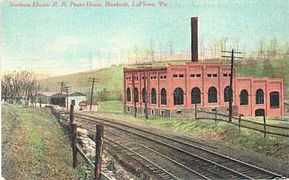Scranton, Montrose and Binghamton Railroad
| Scranton, Montrose and Binghamton Railroad | |
|---|---|
| Overview | |
| Other name | Northern Electric |
| Type | Electric railway |
| System | Overhead wire |
| Status | Partially Abandoned, Part rail-trail |
| Locale | Lackawanna County, Pennsylvania, Wyoming County, Pennsylvania, Susquehanna County, Pennsylvania |
| Termini |
Scranton, Pennsylvania Montrose, Pennsylvania |
| Stations | Scranton, Chinchilla, Clarks Summit, Dalton, Factoryville, Nicholson, Hop Bottom (Foster), Montrose, Lake Winola |
| Ridership | 1915: 2,222,872 |
| Operation | |
| Opening | July 1, 1907 |
| Closed | September 21, 1932 |
| Depot(s) | 227 Wyoming Ave, Scranton, PA |
| Technical | |
| Line length | 49.00 mi (78.86 km) |
| Track gauge | 1,435 mm (4 ft 8 1⁄2 in) standard gauge |
| Electrification | Brookside Power Plant, La Plume, PA |
| Operating speed | Scheduled average 30 MPH, Maximum 60 MPH |
History
The Scranton, Montrose and Binghamton Railroad Company was an interurban railway, commonly referred to as the Northern Electric railway, which ran between downtown Scranton, Pennsylvania and its suburbs to the northwest, including Clarks Summit, Dalton, Factoryville and Montrose.
Formation
Incorporated on January 20, 1904, actual construction began in March, 1906. The first revenue service between downtown Scranton and Dalton, PA commenced July 1, 1907.[1] A branch was also built to Lake Winola and opened Memorial Day in 1908. The final leg to Montrose was opened on August 16, 1915.[2] The company intended to complete the line all the way to Binghamton, but those plans never materialized as automobile usage increased and highways were built.
Operations
Like other interurbans throughout the country, its heyday was in the 1910s. Passenger and freight service ran from the depot on Wyoming Ave. in Scranton, from 6:00AM until 10:30PM, every 20 minutes. Service to Lake Winola was run every 60 minutes, starting at 6:30AM, with the last return trip to Scranton leaving the lake at 10:20PM.[3] It used the Scranton Railway tracks on Providence Ave. until the trolleys reached Providence Square (the intersection of North Main and West Market St.) At that point they traversed Northern Electric tracks up West Market St. to the city line and beyond. Electric power for the line was generated at the Brookside power plant in La Plume, near Dalton, with substations at Chinchilla and Foster. It built two trolley parks with pavilions, roller coasters and carousels; one was in Clarks Summit, the other at Lake Winola.
Decline
When the Delaware, Lackawanna and Western Railroad abandoned its old route between Clarks Summit and Hallstead in 1915, it gave the roadbed to the Commonwealth of Pennsylvania for the express purpose of building a new highway. The road, called the Lackawanna Trail, was completed in 1922 (it is today's US Route 11 between Clarks Summit and Great Bend).[4] Since this new highway largely paralleled the route of the Northern Electric, it almost immediately began to siphon passenger and local freight traffic from the rail line.
The Lake Winola branch was converted to bus operation in 1926. By January 31, 1929, the railroad entered receivership due to decreasing revenues and increasing maintenance costs. In 1930, the line was cut back from Montrose to Nicholson, then to Factoryville. A plan was developed to convert the whole operation to buses in 1931, and 25 were purchased in preparation for the changeover. However, the Northern Electric was not awarded operating rights for the route (it went to Frank Martz Coach Company instead). The company was then forced into bankruptcy. Trustees wanted to end operations on the line in June, 1931, and to scrap the line by October, 1931. Operations were suspended on July 20, 1931.[5] A group of employees formed a cooperative to purchase and run the line between Scranton and Factoryville before it could be scrapped. They began operations in mid-December 1931.[6]
Abandonment
When the city of Scranton decided to begin extensive construction improvements on West Market St. to the city line in Leggett's Gap in 1932, city council insisted that the Northern Electric pay for the cost of realigning and paving its tracks on West Market Street. Since the railway cooperative could not afford the reconstruction costs, the city officials blocked its trolleys from entering the city at Leggett's Gap on September 21, 1932, abruptly and permanently ending almost 25 years of operation.[7]
Legacy
Efforts began in 2014 to restore portions of the route as walking trails.[8]
-

Brookside power plant in La Plume, as built in 1907
-

Brookside Power plant in 2013, now a do it yourself center
References
- ↑ The Scranton Republican, July 2, 1907, p. 5
- ↑ Flanagan, Thomas F. Northern Electric Railway. Ben Rohrbeck Traction Publications, 1980.
- ↑ The Scranton Truth, May 8, 1908, p. 5.
- ↑ The Lackawanna Trail. http://lackawannatrail.railfan.net/
- ↑ The Scranton Republican, July 21, 1931, pp. 7, 10
- ↑ The Scranton Republican, Dec. 7, 1931, p. 3
- ↑ Flanagan, Thomas F. Northern Electric Railway. Ben Rohrbeck Traction Publications, 1980.
- ↑ The Trolley Trail, http://www.countrysideconservancy.org/trails/trolley-trail.html